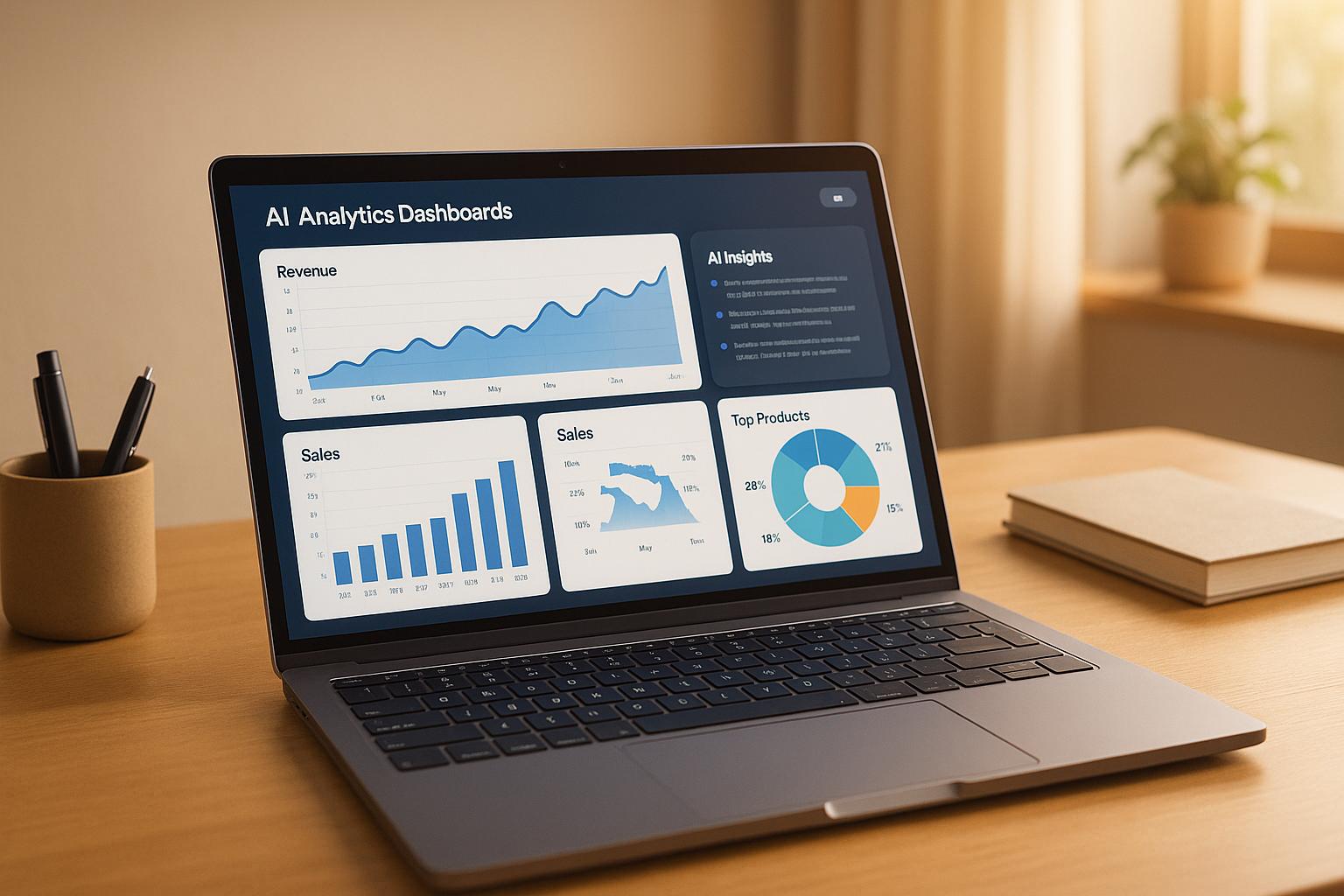
How to Set Up Secure AI Collaboration for Remote Teams

Remote teams need secure AI tools to work efficiently without risking sensitive data. Here's how to set up a secure collaboration environment:
- Understand Team Needs: Identify inefficiencies in workflows and choose AI tools that address specific challenges, like managing time zones or consolidating platforms.
- Prioritize Security: Select platforms with AES-256 encryption, multi-factor authentication, and compliance with regulations like SOC 2 Type II and GDPR.
- Set Up Secure Access: Use role-based permissions, single sign-on (SSO), and mobile device management (MDM) to control access and protect devices.
- Train Your Team: Provide practical training on secure usage and create simple guides for daily tasks to reduce human error.
- Monitor and Update: Regularly update software, track user activity, and set alerts for unusual behavior to stay ahead of potential risks.
Platforms like BrainChat.AI offer features like encrypted data, admin controls, and data ownership, making them a solid choice for secure AI collaboration. By balancing productivity with strong security measures, your team can collaborate effectively while safeguarding sensitive information.
Key Steps to Set Up Secure AI Collaboration Tools
Assessing Team Needs and Goals
Understanding your team's needs is critical when setting up secure AI collaboration tools. Start by analyzing current workflows to identify inefficiencies. Are team members juggling multiple apps, missing important messages, or losing track of project updates? Pinpoint these issues with specific examples. For instance, if your marketing team spends half an hour every morning catching up on messages across five different tools, that's a clear area where AI could streamline communication. Similarly, if developers struggle with asynchronous code reviews across time zones, an AI tool that summarizes changes and flags key issues could be a game-changer.
Consider your team's technical comfort level too. A tech-savvy group might benefit from features like automated code analysis or advanced workflow automation. On the other hand, a sales team might find AI tools more helpful for meeting summaries or lead scoring. Knowing these preferences upfront ensures you don’t waste resources on features no one will use.
Budget is another important factor. Beyond the monthly subscription fee, account for implementation time, training costs, and any productivity dips during the transition. For example, a $15/user/month platform might seem affordable but could come with hidden costs if setup and training take longer than expected.
Checking Platform Security Features
When evaluating security, start with encryption standards. Look for platforms that use AES-256 encryption for data at rest and TLS 1.3 for data in transit - these are essential for protecting sensitive information.
Multi-factor authentication (MFA) is a must-have. The platform should support options like authenticator apps, SMS codes, or hardware tokens. Some advanced systems even offer adaptive authentication, which adjusts security requirements based on user behavior or login locations.
Pay attention to data residency and sovereignty if your company operates under specific regulations. Ensure you know where your data is stored and processed. Some platforms allow you to keep data within U.S. borders, while others may use international data centers.
Admin controls are key for managing user access. Look for granular permission settings that let you control who can share files externally, invite users, or access specific AI features. Automated alerts for unusual activity - like large file downloads or after-hours logins - add another layer of protection.
Finally, implement robust audit logging. Comprehensive logs should track user actions, data access, file modifications, and system changes with timestamps and IP addresses. These logs are invaluable for investigating security incidents or meeting compliance requirements.
Once you’ve ensured the platform meets your security needs, focus on setting up secure access and providing thorough training.
Setting Up Secure Access and Training
User provisioning should follow the principle of least privilege. Group users by roles and assign permissions based on their responsibilities. For example, a marketing coordinator doesn't require the same level of access as an IT administrator. Many platforms allow you to create custom permission templates, making it easier to onboard new team members securely.
Single sign-on (SSO) is another essential feature. By integrating your AI collaboration platform with identity providers like Active Directory, Okta, or Google Workspace, you can streamline access while maintaining security. When an employee leaves, their access is automatically revoked across all connected systems.
In remote work settings, device management becomes crucial. Implement mobile device management (MDM) policies to ensure personal devices used for work meet security standards. Some platforms even offer containerized apps that separate work data from personal information on employee devices.
Training is just as important as technical setup. Host practical workshops focused on real-world scenarios your team encounters daily. For example, show them how to securely share a confidential client presentation rather than just explaining file permissions.
Create quick reference guides for common tasks like setting up secure video calls, sharing sensitive documents, and spotting potential security threats. Keep these guides updated and easily accessible.
To maintain long-term security awareness, provide regular refreshers. Monthly email tips or quick security updates during team meetings can help keep everyone informed about emerging threats or new platform features. The goal is to integrate security into your team's daily habits rather than treating it as an afterthought.
How to Protect Sensitive Data in AI Collaboration
Using Data Encryption and Secure Networks
Keeping sensitive information safe begins with strong encryption throughout your AI collaboration process. It’s essential to secure data both while it’s stored and during transmission.
For stored data, rely on AES-256 encryption - a robust algorithm resistant to quantum threats. This encryption is ideal for securing files, messages, and databases. Additionally, ensure your platform uses FIPS 140-3 compliant encryption algorithms to align with federal security requirements.
When transmitting data between team members or systems, TLS 1.3 with mutual authentication is a reliable choice. This protocol encrypts data in transit and protects your communications from unauthorized access.
AI Platforms Built for Secure Remote Collaboration
Key Features of BrainChat.AI
When it comes to remote teams, security and seamless integration are non-negotiable. BrainChat.AI addresses these needs by combining advanced security protocols with flexible AI integration. This platform enables teams to work with multiple AI models - like OpenAI, Claude, Gemini, Mistral, and DeepSeek - all within a single, secure workspace.
"We built BrainChat for Teams to help businesses integrate multiple AI models seamlessly into their workflows." – Ryan Morrison, CEO, BrainChat.AI
The admin console provides managers with complete oversight of team collaboration. From assigning user roles to setting AI usage limits, administrators can fine-tune access and permissions, ensuring operations stay both efficient and secure. This eliminates the hassle of managing multiple subscriptions or platforms.
One standout feature is the platform's approach to data ownership. BrainChat.AI ensures your organization retains full control over its proprietary information. With strong encryption and strict usage controls, sensitive data stays confidential. Both inputs and outputs remain under your team’s control, an essential safeguard for industries handling private or regulated information.
Collaboration tools are another highlight. Teams can use shared folders, prompt libraries, in-chat comments, and @mentions to streamline workflows. You can also upload documents for AI-powered analysis, create reusable prompts, and monitor activity through detailed analytics dashboards. For those transitioning from other platforms, BrainChat.AI supports importing and exporting ChatGPT conversations, simplifying the migration process.
Security is at the core of BrainChat.AI, as shown in the comparison table below. These robust features ensure compliance with top enterprise standards.
Security Features Comparison
The table below showcases how BrainChat.AI meets enterprise-grade security requirements:
| Security Feature | BrainChat.AI Implementation |
|---|---|
| Data Encryption at Rest | AES-256 encryption |
| Data Encryption in Transit | TLS 1.2+ encryption |
| Multi-Factor Authentication | Included in all business plans |
| SOC 2 Type 2 Compliance | Certified |
| GDPR Compliance | Certified |
| Data Training Opt-out | Available on Pro, Team, and Enterprise plans |
| Admin Console | Full-featured management for user roles and permissions |
| API Key Encryption | Stored as encrypted data |
Multi-factor authentication is included across all business plans, offering an added layer of protection against unauthorized access - even if passwords are compromised.
Additionally, while free plans may allow data to be used for AI model training, all paid plans guarantee that your company’s data remains private and excluded from training purposes. This is critical for organizations managing sensitive information or operating in regulated sectors.
BrainChat.AI’s pricing reflects its focus on secure and efficient team collaboration. The Starter plan begins at $7 per user per month for teams of five or more. For $10 per user per month, the Business plan adds access to multiple AI models and advanced reporting tools. Enterprise plans, designed for organizations needing private cloud deployment and custom integrations, are available at custom pricing.
sbb-itb-f296c05
Best Practices for Secure and Productive AI-Powered Remote Teams
Regular Software Updates and Monitoring
Keeping your AI platform up to date is essential for maintaining security and efficiency. Regular updates help patch vulnerabilities, and automating these updates or scheduling monthly checks ensures nothing slips through the cracks. Use the platform's analytics dashboards to track user behavior, file access patterns, and AI model usage. Pay close attention to anomalies like sudden spikes in data downloads, unusual login times, or access attempts from unfamiliar locations. Set up alerts for specific red flags, such as multiple failed login attempts or large file transfers outside normal business hours. Monitoring these activities not only helps identify potential security threats but also provides insights into how your team uses AI tools, allowing you to refine workflows and pinpoint training needs. These steps create a strong foundation for a security-focused work environment.
Building a Security-Aware Team Culture
Since human error is a leading cause of data breaches, fostering a team culture that prioritizes security is crucial. Start with comprehensive training that goes beyond generic cybersecurity tips to address AI-specific risks and practices. Tailor this training to individual roles to make it relevant and engaging. For instance, employees handling sensitive client data might need in-depth guidance on data classification and sharing policies.
Make training sessions interactive and frequent, focusing on AI-related risks while reinforcing clear policies. Encourage leadership to actively participate in these initiatives - when senior management leads by example, it reinforces that security is a shared responsibility. Develop straightforward, jargon-free policies outlining acceptable AI tool usage, data handling procedures, and incident reporting mechanisms. Create open communication channels between security teams, data scientists, and employees so that everyone feels comfortable raising questions or concerns about AI security. This collaborative approach helps spot potential problems early and ensures every team member understands their role in safeguarding information. Beyond training, secure AI usage is key to protecting sensitive data.
Using AI Features While Protecting Privacy
Striking the right balance between productivity and privacy means understanding how AI features can impact sensitive data. Automated workflows can streamline operations, but they must be implemented securely. For example, if you're using AI to categorize and route customer inquiries, ensure the system doesn’t store or share sensitive customer details with external servers. Tools like BrainChat.AI, which allow organizations to retain data ownership, can help address these concerns - but it's still important to configure automation rules carefully.
Incorporate strong encryption practices and precise configurations for AI automation to align with your security framework. Enforce strict data governance policies across models and user access. Use auto-labeling to flag sensitive documents so employees can easily identify confidential information. Data Loss Prevention (DLP) tools are another layer of protection, preventing accidental leaks when team members copy or paste data into AI interfaces.
Additionally, tiered access controls and regular reviews of AI-assisted work involving sensitive data can help ensure accuracy and mitigate risks. Encourage good data hygiene practices, such as clearing AI chat histories, removing outdated shared prompts, and archiving completed projects. These habits reduce the amount of sensitive information stored, making it easier to manage and secure data over time.
AI in Remote Work: The Secret to Boosting Your Team’s Efficiency
Conclusion: Building a Secure and Productive AI Collaboration Environment
Creating a secure environment for AI collaboration means finding the right balance between productivity and strong security measures. It all begins with selecting a platform that prioritizes security. Look for features like SOC 2 Type 2 compliance, adherence to GDPR, and encrypted data storage. Platforms like BrainChat.AI offer these critical safeguards while enabling seamless collaboration.
Protecting data is at the heart of any secure system. This requires clear policies around encryption, access controls, and compliance audits. The most effective strategies combine advanced technical solutions, like automated monitoring systems, with a well-informed team. Regular training and open communication foster a workplace culture that prioritizes security, ensuring employees are both aware of and engaged in protecting sensitive information.
Consistent vigilance is non-negotiable. Investing in secure AI collaboration tools doesn’t just reduce risks - it also enhances workflows. Tools offering features like custom AI agents, analytics dashboards, and document-based AI interactions can streamline operations while keeping security intact. Regular software updates, ongoing monitoring, and periodic reviews of security policies are essential to maintain a strong defense against emerging threats.
Security isn’t just a safeguard - it’s a productivity enabler. By embedding security practices into daily operations, such as automated threat detection and team training, organizations can unlock the full potential of AI tools without jeopardizing sensitive data. This approach shifts security from a hurdle to a key driver of confident and efficient remote collaboration.
As remote work becomes more reliant on AI-powered tools, establishing secure collaboration frameworks is no longer optional. It’s a necessity for staying competitive and ensuring compliance in an increasingly digital world.
FAQs
What security features should I prioritize when choosing an AI collaboration platform for remote teams?
When choosing an AI collaboration platform for remote teams, security should be at the top of your checklist. Start with end-to-end encryption to keep data safe, both in transit and at rest. Next, ensure the platform offers multi-factor authentication (MFA) and role-based access controls - these features limit access to sensitive information to only those who need it. Additionally, look for tools that include activity monitoring to detect unusual behavior and help meet privacy standards like GDPR or CCPA.
By prioritizing these security features, your team can work together effectively while keeping data secure in a remote work setting.
How can remote teams keep their data private and secure when using AI tools?
To safeguard sensitive information while using AI tools, remote teams should establish clear usage policies and ensure team members are trained on best practices. For example, emphasize the importance of not sharing personal or confidential details with AI systems. Implementing role-based access controls is another critical step, as it limits data access strictly to those who require it. Regularly monitoring AI activity can also help teams quickly detect and address any potential security issues.
Another key practice is data minimization - collecting and storing only the information that is absolutely necessary. This approach not only reduces the risk of data breaches but also makes it easier to comply with privacy regulations. By focusing on these measures, teams can maintain a strong balance between leveraging AI for productivity and ensuring robust data security in remote work environments.
What are the best ways to train remote teams on secure AI collaboration?
Training remote teams to collaborate securely with AI works best when you mix hands-on learning with engaging, interactive methods. Think about incorporating activities like workshops, real-world scenarios, and collaborative team projects. These not only help team members get comfortable with AI tools but also strengthen their understanding of how to use them effectively.
Leveraging AI-driven training platforms can take this a step further. Platforms offering self-paced, localized, and interactive modules make it easier for team members to stay informed about best practices while promoting a mindset of security awareness. By blending skill development with a focus on security, your team can confidently and safely work together, no matter where they’re located.
Related Blog Posts
Turbocharge your team with BrainChat AI
Teams using BrainChat report a 40% boost in task completion speed. Imagine what your team could achieve.
%20(1).png)


